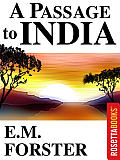|
Serving over
22 millions NRIs worldwide
|
|
|||||||||||||||||||||||||||||||||||
|
||
|
'A Passage to India' ( based on
E.M. Forster's classic novel)
*eBook
Summary: The novel begins with people very much desiring to connect and to overcome the stereotypes and biases that have divided the two cultures. Mrs. Moore accompanies her future daughter-in-law Adela Quested to India where both are to meet Mrs. Moore's son Ronny, the City Magistrate. Adela says from the outset that she wishes to see the "real India" and Mrs. Moore soon befriends an Indian doctor named Aziz. Cyril Fielding, an Englishman and the principal of a local government college, soon becomes acquainted with everyone, and it is his uneasy friendship with Dr.Aziz that constitutes the backbone of the novel. Although the primary characters all take pains to accept and embrace difference, their misunderstanding, fear and ignorance make connection more difficult than any of them expect. Mrs. Moore and Adela Quested find that surpassing their preconceived notions and cultural norms entails confronting frightening notions about the contingency of their beliefs and values. Getting to know the "real" India proves to be a much more difficult and upsetting task than they had imagined. For Aziz, the continued indignities of life under British rule and the insults-intentional and unintentional-of his English acquaintances make him suspect that although friendship is desired, the two cultures are not yet ready for it. Forster's keen eye for social nuance and his capacious sympathy for his characters make A Passage to India not only a balanced investigation of the rift that divides English and Indian but also a convincing and moving work of art. Written in 1924, two years after the publication of Eliot's The Waste Land and Joyce's Ulysses and one year before Woolf's Mrs. Dalloway, Forster's masterpiece was produced during one of the most remarkable periods of achievement in English literature since Wordsworth's da
|
||
|
|

